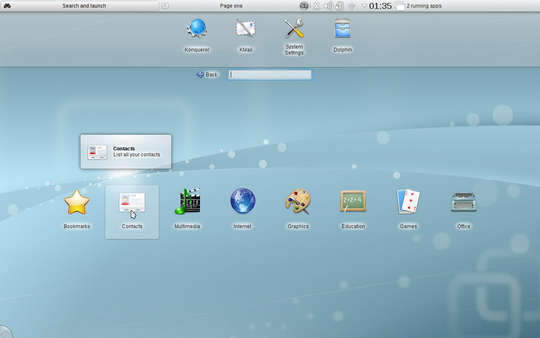
Plasma Netbook's Search and Launch interface offers applications, contacts and desktop search
Plasma Desktop and Netbook 4.5.0: improved user experience
KDE Community launches Plasma Desktop and Netbook 4.5.0
10th August, 2010. KDE today releases the Plasma Desktop and Plasma Netbook Workspaces 4.5.0. Plasma Desktop received many usability refinements. The Notification and Job handling workflows have been streamlined. The notification area has been cleaned up visually, and its input handling across applications is now made more consistent by the extended use of the Freedesktop.org notification protocol first introduced in Plasma's previous version.

Plasma Netbook's Search and Launch interface offers applications, contacts and desktop
search
KDE, an international Free Software community, is happy to announce the immediate availability of the Plasma Desktop and Netbook workspaces in version 4.5. The Plasma Workspaces see both refinement and innovation towards semantic, task-driven workflows. In addition to thousands of bugs that have been fixed in order to make the user experience more complete, more usable and more attractive, some interesting changes are included in this release:
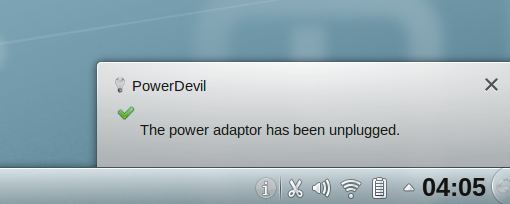
Plasma Desktop's notifications have received polish in handling, display and
appearance
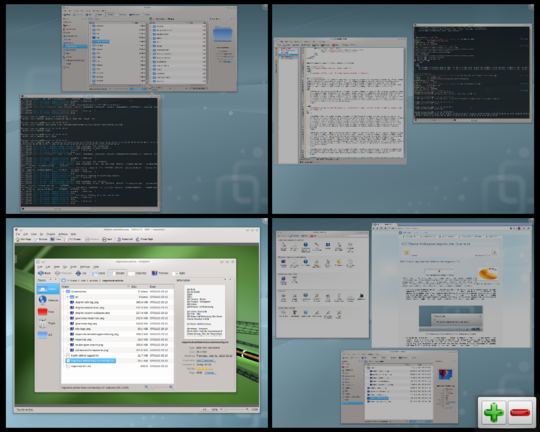
You can now add and remove virtual desktops conveniently from the Desktop Grid
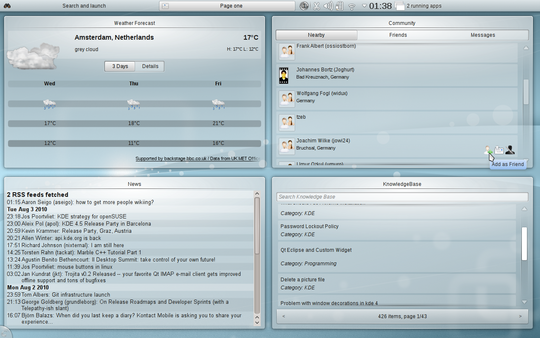
Plasma Netbook's Page One is designed to keep tabs on the social web, it can
hold any Plasma widget
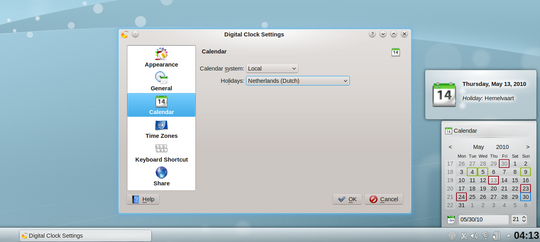
Clicking on the clock reveals the calendar, which displays holidays in your region
A variety of other improvements span changes to KRunner’s display of results, configurable panel icon sizes, easy panel configuration using JavaScript templates and shadows, better drag and drop in the Quick Launch widget, which now allows favorite applications to be arranged in multiple columns and rows, improvements in Dolphin, Konsole, and much more. It has also been made possible to start Plasma applets as separate applications through the plasma-windowed application. The Removable Device Notifier now shows errors more clearly.
Workspace Setup Restructured
The configuration for the workspace has been restructured and is now offered through a category in System Settings. The new Workspace section provides control over the Look and Feel of your Plasma workspace. Here you can set the theming to your liking, enable or disable the Semantic Desktop & Desktop Search features, and enable many settings that make your workspace work the way you want it to, be it hot corners, visual helpers used for managing windows, the new window tiling feature, and many more.
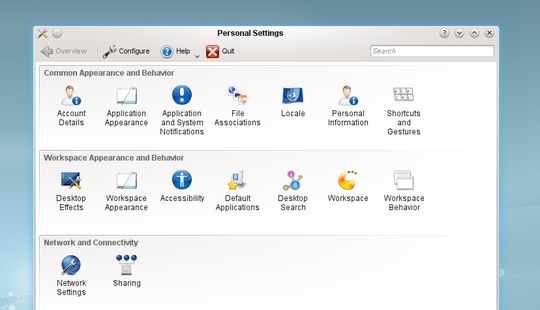
The Workspace section in System Settings gives you full control over the look and
feel of your workspace.
Workspace effects enhance the user experience in many ways. These include the usage of OpenGL-rendered window previews in the taskbar, and a desktop grid effect which enables you to zoom in and out of virtual desktops. If your hardware or graphics driver does not support these graphical effects properly, Plasma falls back gracefully to traditional 2D rendering. We recommend using the latest version of the graphics driver and underlying XOrg stack for the best performance. In 4.5, it is now possible for administrators and distributors to gain finer control over graphics hardware and drivers used through the use of per-effect blacklists [ http://blog.martin-graesslin.com/blog/2010/07/blacklisting-drivers-for-some-kwin-effects/ ]. This makes it easier to enable and disable certain features based on their availability and stability on certain systems. It also makes it easier to provide a smoother experience out of the box to many users.
More Screenshots...
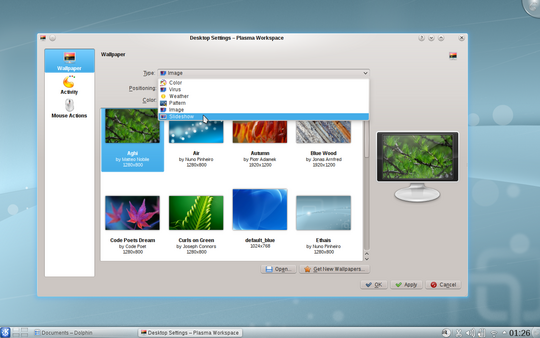
The Desktop Settings user interface has seen some nice usability enhancements

Running jobs are visualized by Plasma, ...
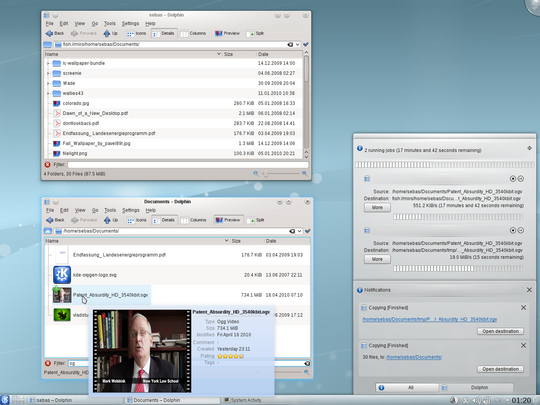
... multiple jobs are grouped and notifications are remembered for a while.
Plans and Work in Progress
The Plasma team is working on further performance improvements in window management.
Also on the agenda is extending the concepts of Activities, the intentional and
automatic grouping of related windows and supporting desktop furniture, making the
workspace and applications more context-aware, including the use of geolocation.
Effects such as blurring transparent window backgrounds are being employed to increase
ergonomics while looking good, by making text and user interface elements more readable.
New Plasma Workspaces for Media Center use-cases and mobile phones are also on their
way. During the recent Akademy conference, the first phone call was made using the
new Plasma Mobile shell.
Installing Plasma
KDE software, including all its libraries and its applications, is available for free under Open Source licenses. KDE software runs on various hardware configurations, operating systems and works with any kind of window manager or desktop environment. Besides Linux and other UNIX based operating systems you can find Microsoft Windows versions of most KDE applications on the KDE software on Windows [ http://windows.kde.org ] site and Apple Mac OS X versions on the KDE software on Mac site [ http://mac.kde.org/ ]. Experimental builds of KDE applications for various mobile platforms like MeeGo, MS Windows Mobile and Symbian can be found on the web but are currently unsupported.
KDE software can be obtained in source and various binary formats from http://download.kde.org and can also be obtained on CD-ROM [ http://www.kde.org/download/cdrom.php ] or with any of the major GNU/Linux and UNIX systems [ http://www.kde.org/download/distributions.php ] shipping today.
Packages. Some Linux/UNIX OS vendors have kindly provided binary packages of 4.5.0 for some versions of their distribution, and in other cases community volunteers have done so.
Some of these binary packages are available for free download from KDE's http://download.kde.org [ http://download.kde.org/binarydownload.html?url=/stable/4.5.0/ ]. Additional binary packages, as well as updates to the packages now available, will become available over the coming weeks.
Package Locations. For a current list of available binary packages of which the KDE's Release Team has been informed, please visit the 4.5 Info Page [ http://www.kde.org/info/4.5.0.php ].
Compiling 4.5.0
The complete source code for 4.5.0 may be freely downloaded [ http://download.kde.org/stable/4.5.0/src/ ]. Instructions on compiling and installing KDE software 4.5.0 are available from the 4.5.0 Info Page [ http://www.kde.org/info/4.5.0.php#binary ].
System Requirements
In order to get the most out of these releases, we strongly recommend to use
the latest version of Qt, as of today 4.6.3. This is necessary in order to assure
a stable experience, as some improvements made to KDE software have actually been
done in the underlying Qt framework.
Graphics drivers may under certain conditions fall back to XRender rather than OpenGL
for compositing. If you have issues with notably slow graphics performance, switching
off desktop effects is likely to help, depending on the graphics driver and setup
used. In order to make full use of the capabilities of KDE's software, we also recommend
to use the latest graphics drivers for your system, as this can improve the user
experience substantially, both in optional functionality, and in overall performance
and stability.
About KDE
KDE is an international technology team that creates free and open source software for desktop and portable computing. Among KDE's products are a modern desktop system for Linux and UNIX platforms, comprehensive office productivity and groupware suites and hundreds of software titles in many categories including Internet and web applications, multimedia, entertainment, educational, graphics and software development. KDE software is translated into more than 60 languages and is built with ease of use and modern accessibility principles in mind. KDE4's full-featured applications run natively on Linux, BSD, Solaris, Windows and Mac OS X.
Trademark Notices. KDE® and the K Desktop Environment® logo are registered trademarks of KDE e.V. Linux is a registered trademark of Linus Torvalds. UNIX is a registered trademark of The Open Group in the United States and other countries. All other trademarks and copyrights referred to in this announcement are the property of their respective owners.
KDE Applications 4.5.0: enhanced usability and map routing
10th August, 2010. The KDE team today releases a new version of the KDE Applications. Many educational titles, tools, games and graphical utilities have seen further enhancement and usability improvements. Routing backed by OpenRouteService has made its entry in Marble, the virtual globe. Konqueror, KDE's webbrowser can now be configured to use WebKit with the KWebKit component available in the Extragear repository.
KDE, an international Free Software community, is happy to announce the immediate availability of the KDE Applications 4.5. Be it the high-quality games, educational and productivity software or the useful tools, these applications have become more powerful, yet easier to use.
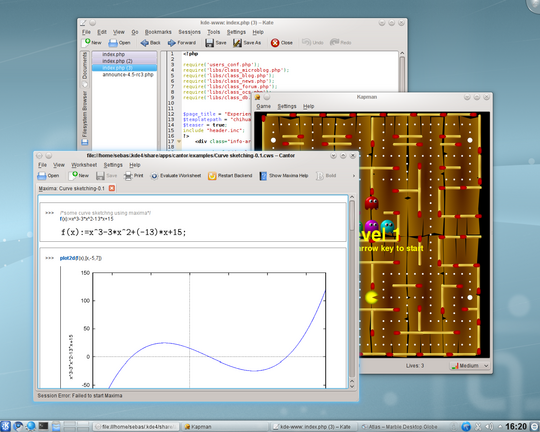
Mathematical, text-editing and entertainment applications
The KDE Applications have been improved in many different areas. Let us highlight a few of the changes which were made.
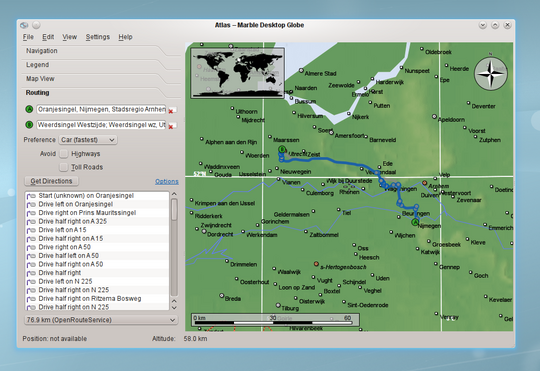
The Marble Desktop Globe can now be used for routing as well
In Konqueror, Adblock lists can now be automatically updated, making for a cleaner web-browsing experience. Users who prefer to use WebKit as the rendering engine can now rely on the KDE-WebKit KPart. Gwenview now runs smoothly without blocking even while applying processor-intensive effects. Its image editing operations now properly retain all EXIF metadata. Gwenview also sees many usability improvements and increased configurability. Finally, KInfoCenter, which gives the user an overview of the hardware and software configuration of his or her system, has seen some major work this release, with usability improvements to its main window and better stability.
More Screenshots...
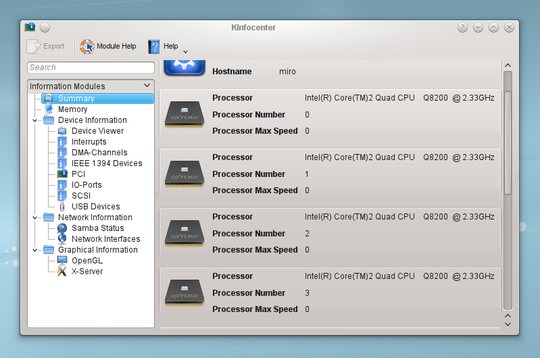
KInfoCenter, which shows information about your system has been visually revamped
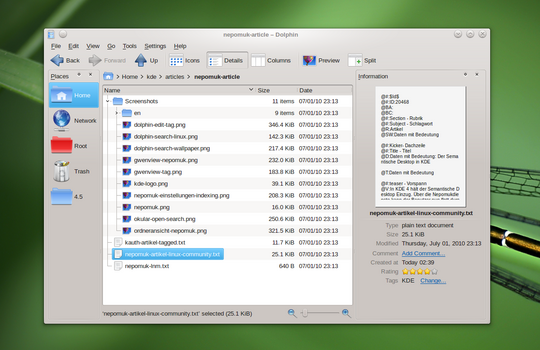
Semantic Desktop features in Dolphin provide useful metadata
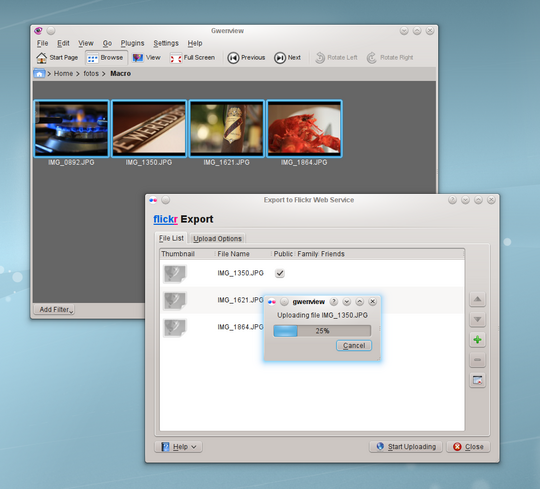
With Gwenview you can easily share your pictures on the web using your favourite
picture service
Installing KDE Applications
KDE software, including all its libraries and its applications, is available
for free under Open Source licenses. KDE software runs on various hardware configurations,
operating systems and works with any kind of window manager or desktop environment.
Besides Linux and other UNIX based operating systems you can find Microsoft Windows
versions of most KDE applications on the KDE software on Windows [ http://windows.kde.org
] site and Apple Mac OS X versions on the KDE software on Mac site [ http://mac.kde.org/
]. Experimental builds of KDE applications for various mobile platforms like MeeGo,
MS Windows Mobile and Symbian can be found on the web but are currently unsupported.
KDE software can be obtained in source and various binary formats from http://download.kde.org
[ http://download.kde.org/stable/4.5.0/ ] and can also be obtained on CD-ROM [ http://www.kde.org/download/cdrom.php
] or with any of the major GNU/Linux and UNIX systems [ http://www.kde.org/download/distributions.php
] shipping today.
Packages. Some Linux/UNIX OS vendors have kindly provided binary packages of
4.5.0 for some versions of their distribution, and in other cases community volunteers
have done so.
Some of these binary packages are available for free download from KDE's http://download.kde.org
[ http://download.kde.org/binarydownload.html?url=/stable/4.5.0/ ]. Additional binary
packages, as well as updates to the packages now available, will become available
over the coming weeks.
Package Locations. For a current list of available binary packages of which the KDE's Release Team has been informed, please visit the 4.5 Info Page [ http://www.kde.org/info/4.5.0.php ].
Compiling 4.5.0
The complete source code for 4.5.0 may be freely downloaded [ http://download.kde.org/stable/4.5.0/src/ ]. Instructions on compiling and installing KDE software 4.5.0 are available from the 4.5.0 Info Page [ http://www.kde.org/info/4.5.0.php#binary ].
System Requirements
In order to get the most out of these releases, we strongly recommend to use
the latest version of Qt, as of today 4.6.3. This is necessary in order to assure
a stable experience, as some improvements made to KDE software have actually been
done in the underlying Qt framework.
Graphics drivers may under certain conditions fall back to XRender rather than OpenGL
for compositing. If you have issues with notably slow graphics performance, switching
off desktop effects is likely to help, depending on the graphics driver and setup
used. In order to make full use of the capabilities of KDE's software, we also recommend
to use the latest graphics drivers for your system, as this can improve the user
experience substantially, both in optional functionality, and in overall performance
and stability.
About KDE
KDE is an international technology team that creates free and open source software for desktop and portable computing. Among KDE's products are a modern desktop system for Linux and UNIX platforms, comprehensive office productivity and groupware suites and hundreds of software titles in many categories including Internet and web applications, multimedia, entertainment, educational, graphics and software development. KDE software is translated into more than 60 languages and is built with ease of use and modern accessibility principles in mind. KDE4's full-featured applications run natively on Linux, BSD, Solaris, Windows and Mac OS X.
Trademark Notices. KDE® and the K Desktop Environment® logo are registered trademarks of KDE e.V. Linux is a registered trademark of Linus Torvalds. UNIX is a registered trademark of The Open Group in the United States and other countries. All other trademarks and copyrights referred to in this announcement are the property of their respective owners.
KDE Development Platform 4.5.0 gains performance, stability, new high-speed cache and support for WebKit
10th August, 2010. KDE today releases the KDE Development Platform 4.5.0. This release brings many performance and stability improvements. The new KSharedDataCache is optimized for fast access to resources stored on disk, such as icons. The new KDE WebKit library provides integration with network settings, password-storage and many other features found in Konqueror.
KDE, an international Free Software community, proudly announces the release of the KDE Platform 4.5. This basis for the Plasma Workspaces and Applications developed by KDE has seen significant improvements in many areas. Besides the introduction of new technology, a lot of work has been spent on improving the performance and stability of the underlying pillars of KDE development. KDE Platform has progressed in many areas, both in terms of infrastructure and of development tools.
Plans and Work in Progress
The KDE platform team is working on making the KDE Platform more suitable for mobile devices. With the introduction of KDE's platform profiles, it is possible to compile KDE with limited feature sets in order to minimise their footprint. These profiles are still being elaborated to meet mobile apps' needs. The plans include using it for the mobile versions of Kontact, KOffice and the Plasma Mobile workspace. The BlueDevil framework will add better support for many Bluetooth devices in upcoming versions. BlueDevil, which is based on BlueZ, found on many Linux systems, is maturing quickly and is currently going through a series of beta releases. Its developers are aiming at a release included with the KDE Platform 4.6 in January 2011.
Installing the KDE Development Platform
KDE software, including all its libraries and its applications, is available for free under Open Source licenses. KDE software runs on various hardware configurations, operating systems and works with any kind of window manager or desktop environment. Besides Linux and other UNIX based operating systems you can find Microsoft Windows versions of most KDE applications on the KDE software on Windows [ http://windows.kde.org ] site and Apple Mac OS X versions on the KDE software on Mac site [ http://mac.kde.org/ ]. Experimental builds of KDE applications for various mobile platforms like MeeGo, MS Windows Mobile and Symbian can be found on the web but are currently unsupported.
KDE software can be obtained in source and various binary formats from http://download.kde.org and can also be obtained on CD-ROM [ http://www.kde.org/download/cdrom.php ] or with any of the major GNU/Linux and UNIX systems [ http://www.kde.org/download/distributions.php ] shipping today.
Packages. Some Linux/UNIX OS vendors have kindly provided binary packages of
4.5.0 for some versions of their distribution, and in other cases community volunteers
have done so.
Some of these binary packages are available for free download from KDE's http://download.kde.org.
Additional binary packages, as well as updates to the packages now available, will
become available over the coming weeks.
Package Locations. For a current list of available binary packages of which the KDE's Release Team has been informed, please visit the 4.5 Info Page [ http://www.kde.org/info/4.5.0.php ].
Compiling 4.5.0
The complete source code for 4.5.0 may be freely downloaded [ http://download.kde.org/stable/4.5.0/src/ ]. Instructions on compiling and installing KDE software 4.5.0 are available from the 4.5.0 Info Page [ http://www.kde.org/info/4.5.0.php#binary ].
System Requirements
In order to get the most out of these releases, we strongly recommend to use the latest version of Qt, as of today 4.6.3. This is necessary in order to assure a stable experience, as some improvements made to KDE software have actually been done in the underlying Qt framework.
Graphics drivers may under certain conditions fall back to XRender rather than OpenGL for compositing. If you have issues with notably slow graphics performance, switching off desktop effects is likely to help, depending on the graphics driver and setup used. In order to make full use of the capabilities of KDE's software, we also recommend to use the latest graphics drivers for your system, as this can improve the user experience substantially, both in optional functionality, and in overall performance and stability.
About KDE
KDE is an international technology team that creates free and open source software for desktop and portable computing. Among KDE's products are a modern desktop system for Linux and UNIX platforms, comprehensive office productivity and groupware suites and hundreds of software titles in many categories including Internet and web applications, multimedia, entertainment, educational, graphics and software development. KDE software is translated into more than 60 languages and is built with ease of use and modern accessibility principles in mind. KDE4's full-featured applications run natively on Linux, BSD, Solaris, Windows and Mac OS X.
Trademark Notices. KDE® and the K Desktop Environment® logo are registered trademarks of KDE e.V. Linux is a registered trademark of Linus Torvalds. UNIX is a registered trademark of The Open Group in the United States and other countries. All other trademarks and copyrights referred to in this announcement are the property of their respective owners.